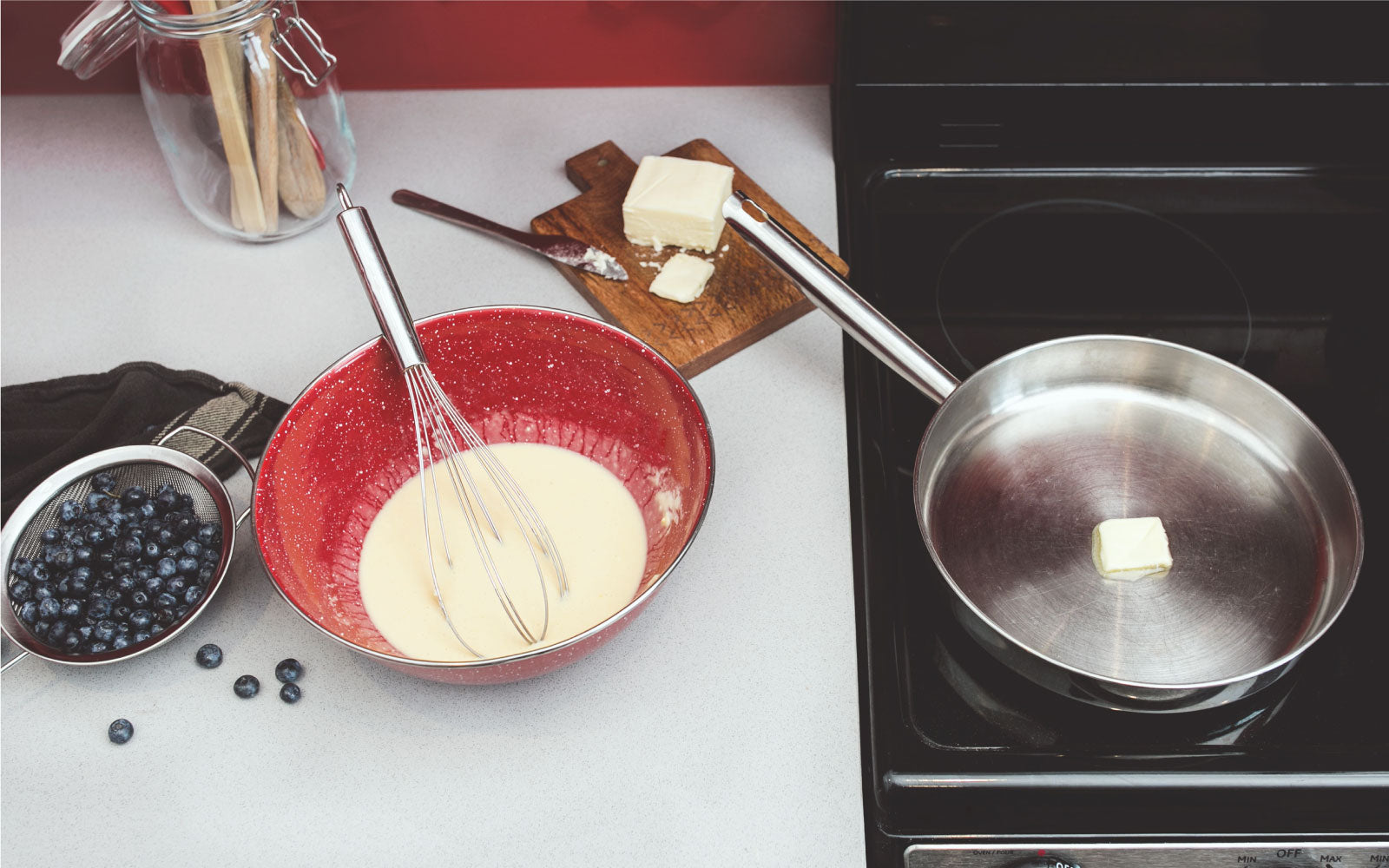
16-20: Simplify Your Kitchen
Professional kitchens run smoothly thanks in part to mise en place (pronounced meez ahn plahs). French for “everything in its place,” chefs set themselves up from the start with all the necessary tools and prepared ingredients, enabling them to efficiently focus on the task at hand when it's time to get cooking. Maybe you've noticed tidy cups of pre-chopped and pre-measured ingredients on cooking shows? It's basically the culinary cousin of knolling. 
We’re fans of applying this practice beyond the kitchen, as Melissa Gray at the Culinary Institute of America explains:
"It really is a way of life... it's a way of concentrating your mind to only focus on the aspects that you need to be working on at that moment, to kind of rid yourself of distractions."

16. What Your Kitchen Needs (and Doesn't)
Clearly we’re fans of clever gadgets that solve a problem, but the kitchen is a place where gadgets get out of hand fast. That’s why we’re with Alton Brown on avoiding unitaskers to help cut clutter. Unless you're committed to eating an egg tube every day, you can skip the Rollie and other internet food fads. Instead, here's a checklist of items we find essential:
- Cutlery, plates, bowls, and drinking glasses
- Knives: Paring, serrated, and chef's knife
- Cutting board (this one has a built-in knife sharpener)
- Pots with lids (we need small, medium, and large)
- Cooking utensils (space-saving sets are the easy button)
- Multipurpose pan (we use our Always Pan daily)
- Measuring cups and spoons
- Nesting mixing bowls (this one with a colander is smart)
- Baking sheet or two (handy from cookies to roasted veggies)
- A potholder that doubles as a trivet
- Pepper grinder
- And don't forget the can opener!
Specialty items like a blender, kettle, or cast-iron skillet are perfectly acceptable if you use them regularly. Beyond investing in quality pieces that multitask well, opting for reusable instead of disposable is a great way to save storage space (and needless waste). For example, one Swedish dishcloth can replace as many as 17 rolls of paper towels!
And aside from the inevitable "junk drawer" that happens to the best of us, you have a better chance of finding what you need if you’ve invested in multitaskers.

17. Take Time to Keep Things Tidy
Mise en place is all about having things at your fingertips. It’s ultimately about ease, efficiency, and even enjoying your experience – so try to find habits that suit your household. For example, little routines like cleaning the kitchen before going to bed; it's wonderful to wake up to when you've made the effort.
Even if your place isn’t short on storage space, a cohesive countertop will help minimize visual clutter – so find a theme and stick with it. For our kitchen, we love Yamazaki, a Japanese housewares brand that’s geared towards those living in small spaces. From wood-and-steel shelves to magnetic spice racks, their basic colors and durable materials lend functional touches to any home.
When it’s apron time, find recipes easily by putting in a little effort up front: Go high tech with Plan to Eat, or take a meticulous lab-notebook approach with Letterfolk’s pocket-sized recipe passport. 
As someone who prefers eating out and only has a handful of go-to recipes in my brain, I've found it helpful to print out recipes that I'm trying for the first time, even printing a page out of one of my recipe books – then I can scribble notes about changes I've tried so next time I know what worked (I have a terrible memory for measurements). And yes, I'm keeping an eye out for a Trapper Keeper.
18. Make a Meal Plan
Meal planning might sound intimidating if you've never done it, but even a little forethought goes a long way. There’s a range of resources out there, so click around and find what method suits your style.
If you’re new to the practice, consider starting with a free meal-planning option so you’re not forking over any cash as you learn. This doesn't need to be fancy or intimidating – we found an unused office calendar and post-it notes, a system that’s working just fine for us for now! Here's a PDF download based on our DIY meal planner. Pro Tip: Use small Post-It Notes for rearranging on the fly.
Ok. Time to visit the grocery store. If you've planned the week in advance, this part is much easier (and you'll find you waste less food by week's end). For optimized grocery shopping, opt for next-level list keeping with Plan to Eat (more on this paid game-changer in a minute). Or in lieu of spending dough on an app, you can:
- simply note your needs with a dedicated pen and notepad by the fridge
- add items to your favorite grocery store’s delivery app (even if you aren't having it delivered)
- speak up and let Alexa or Google Assistant update your list as needed
Don't forget, part of meal planning includes planning not to cook – it's important to give yourself freedom to be spontaneous, and to support local restaurants!
19. Stock Your Pantry
If your meal plan hits a snag and ordering in isn't an option, you’ll appreciate having a well-stocked pantry. Everyone’s pantry will look different based on cooking habits, food preferences and how big your pantry is (heck, if you even have one) – so we won’t make a list of what your pantry should contain.
Instead we’ll simply point out that, in general, it’s smart to stock items that have a long shelf life and can be used for multiple dishes. Think spices, pasta, pickles, condiments, things in cans... What's something you always find yourself reaching for? For me personally, it's pinto beans, tuna, and spicy honey (though not in combination).
And don’t forget the freezer! It’s a great way to hit pause, especially for produce that’s ready to peace out but doesn’t have a spot on your meal plan just yet.
20. The Secret Ingredient: Your Sanity
I don’t know who needs to hear this, but “run the dishwasher twice” if you need to. Whether you enjoy cooking or not, take a step back. You’ve been reading this with a mindset of optimize! improve! lifehack! But if we’ve learned anything from pandemic life, it’s that sanity is job one. Our relationships take priority over things – whether that’s keeping the peace with your partner, cutting your roommate some slack, or calming your uptight inner monolog.
And please, save yourself the stress (and expense) of overhauling your kitchen. Try tweaking your habits and behavior, incorporate some tips and tricks, and be realistic: The best thing for the planet is to use what you already own. If something breaks, repair it if possible; eventually when it’s time to replace it, make your purchase with the planet in mind. This applies to nearly everything, from pots n’ pans to pants.



